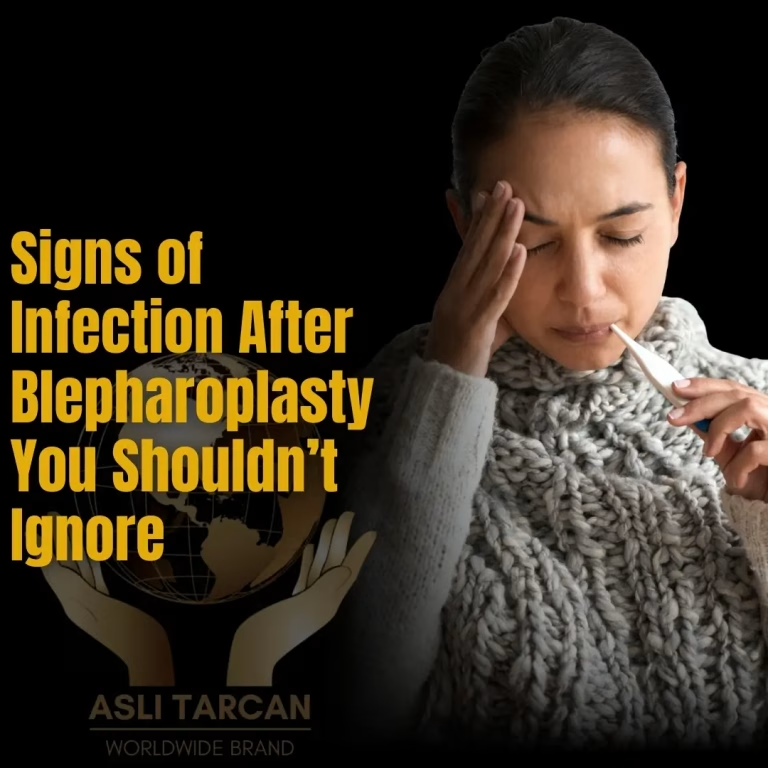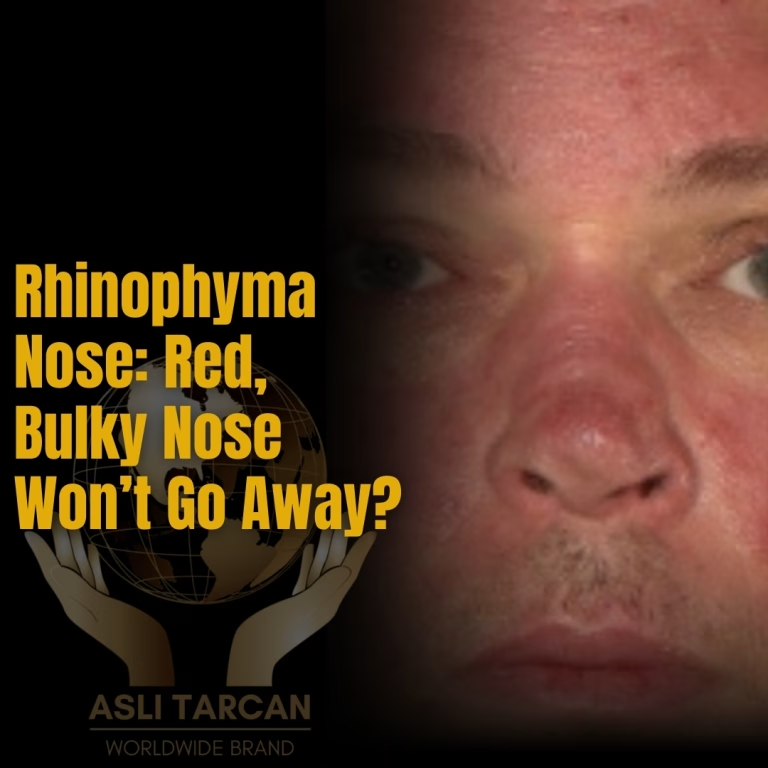What Can You Do About Bad Blepharoplasty Scars?
Bad blepharoplasty scars result from surgical complications or surgeon inexperience, poor healing, sun exposure, or poor lifestyle choices. Noticeable, raised, or lumpy scars with an uneven appearance are uncommon. They make your eyes appear darker and tired, exactly like the appearance you wanted the surgery to fix.
Luckily, it’s possible to fix the bad blepharoplasty scars with massage or medical treatments such as Silicone gel/sheets, Steroid injections, Laser therapy, Microneedling, and Enzymatic treatments.
Let’s discuss all the available treatments to fix blepharoplasty scars, types of scars, and the causes as well.
See Also: Signs of Infection from Blepharoplasty
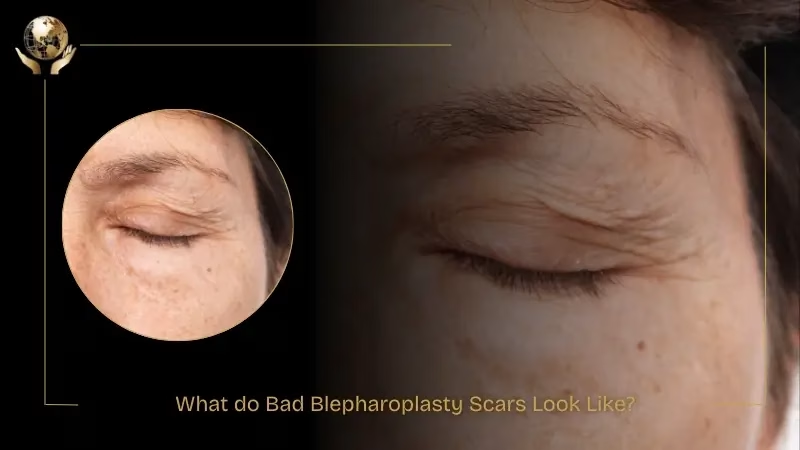
What do Bad Blepharoplasty Scars Look Like?
Bad blepharoplasty scars appear due to surgical errors or individual healing differences. They usually appear as raised or lumpy areas along the eyelid incision line.
Usually, they’re also accompanied by an asymmetric or irregular texture that is totally different from the rest of your skin. The scars are more visible when you’re smiling or blinking, as they’re usually located on the upper part of the eyelid.
They are red, dark, or discolored and easily visible on your eyelids. Because of these scars, your eyes look tired, older, and darker, which sometimes may feel worse than they were before the surgery.
Types of Bad Blepharoplasty Scars
There are different types of blepharoplasty scars, such as:
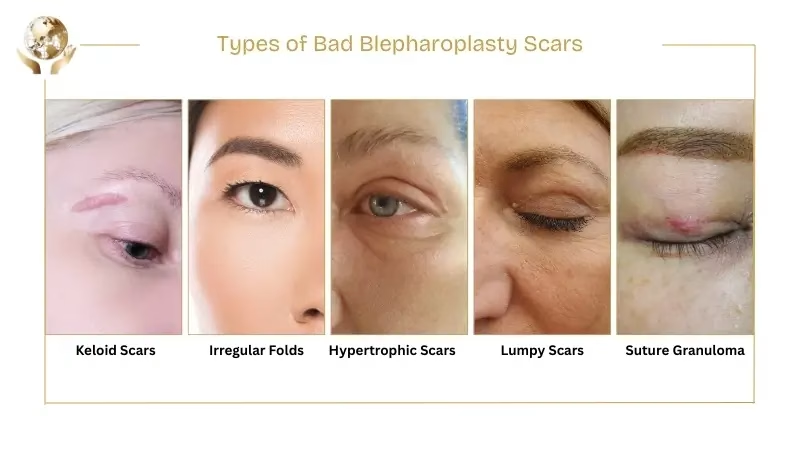
- Keloid Scars: These scars are typically not at the incision site but around it. They’re often firm, dark, and can also be itchy, painful, and hard to treat.
- Irregular Folds: Irregular folds are uneven or rippled skin caused by inconsistent healing. It may make your eyelids look more asymmetric and surgical.
- Hypertrophic Scars: These are the most common bad blepharoplasty scar type. They’re usually thick, raised, and confined to the wound line and could be red or pink in color. They can also feel firm or tight but improve over time.
- Lumpy Scars: This type of scar usually appears near the incision and can naturally smooth out over time with minor treatment.
- Suture Granuloma: The suture granuloma is another type that forms firm nodules along the incision. It’s usually the reaction to leftover stitches, sometimes tender, and often cosmetic.+
See Also: How To Get Rid of Under Eye Bags?
Causes of Bad Blepharoplasty Scars
The reasons for the poor blepharoplasty scars are usually sun exposure, individual healing, poor incision alignment, smoking, and excessive or inward extension.
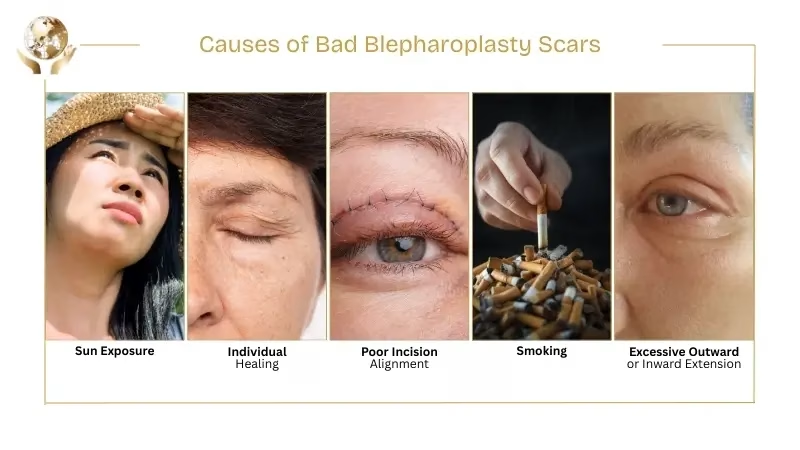
- Sun Exposure: Direct sunlight on surgical eyelids can darken scars.
- Individual Healing: The scars are naturally formed on some people’s eyelids due to their individual way of healing.
- Poor Incision Alignment: When the surgeon doesn’t place the incision in the natural eyelid crease, it could also lead to poor scars from blepharoplasty.
- Smoking: If you continue smoking after the surgery, it could disrupt the healing and worsen the appearance of the scars.
- Excessive Outward or Inward Extension: It’s a surgical error when the surgeon makes the incision way too far beyond the intended area, causing visible irregular scars after blepharoplasty surgery.
See Also: Types of Dark Circles
How to Treat Bad Blepharoplasty Scars?
You have multiple treatments for bad blepharoplasty scars.
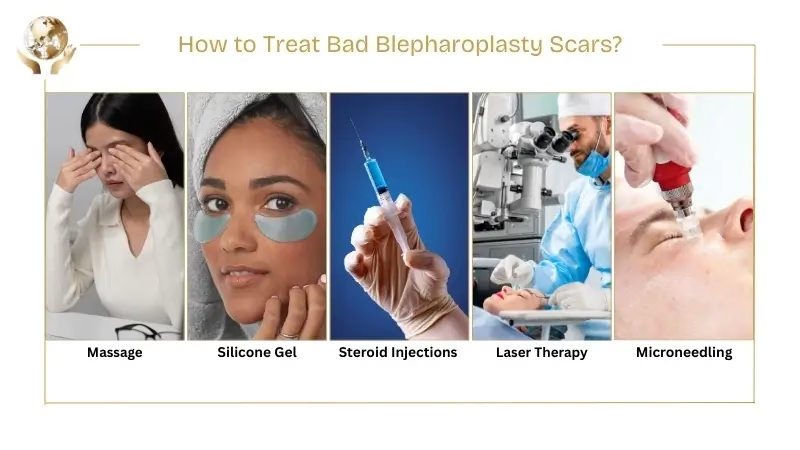
Massage
Massaging blepharoplasty scars early helps soften and break them down. You can start doing this exercise 2 to 3 days after the surgery when the incisions are closed.
Use your clean fingertips or a cotton swab in circular motions on the eyelid, massaging it gently. Do it 2 to 3 times daily for 1 to 2 minutes each time.
Silicone Gel / Sheets
Silicone gel or sheets are proven to reduce scar thickness and redness. They hydrate and regulate collagen production, triggering the natural powers of the skin to heal itself.
You can either use gel or the sheets. The gel is usually easier to use than the sheets on delicate eyelid skin. Use consistently for the best results.
Steroid Injections
If the above methods to remove the scars from blepharoplasty don’t work, you can go for steroid injections.
Tiny doses of corticosteroids like triamcinolone are injected into the raised scars. They reduce inflammation and flatten thick or lumpy scars. It’s a medical treatment done by a plastic surgeon in a clinic or office.
Laser Therapy
Laser therapy is another non-surgical treatment for poor blepharoplasty scars. In it, fractional lasers are used to target and break down the excess tissue, stimulating collagen and remodelling for smoother results. It can improve the texture and the color of the scars.
Microneedling
Microneedling is a popular treatment for blepharoplasty scars that creates tiny controlled punctures to stimulate healing. It helps remodel collagen and smooth out irregular scars. You can combine it with serums for added effect.
Enzymatic Treatments
Enzymatic treatment includes special enzymes applied to your scars to break down excess collagen. They soften and flatten thickened scar tissue. This procedure is usually performed in the office by a professional.

This article is medically reviewed by Ophthalmologist Dr. Mehmet
See Our Doctors & Surgeons
See Also: Polynucleotides Work Timeline
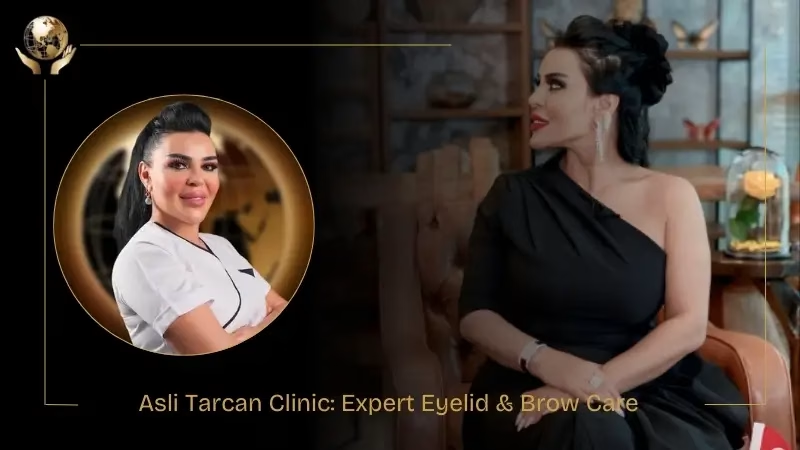
Asli Tarcan Clinic: Expert Eyelid & Brow Care
Bad blepharoplasty looks like raised, lumpy scars, usually accompanied by an uneven appearance of the skin and a darker shade.
They usually happen due to surgical errors such as poor alignment and excessive outward or inward extension. Smoking and sun exposure could also cause them.
The best way to fix bad blepharoplasty scars is massage 2 to 3 times daily for 1 to 2 minutes per session and treatments such as Silicone gel/sheets, laser therapy, microneedling, enzymatic treatment, or steroid injections.
Give your eyes a refreshed and youthful look with Asli Tarcan Clinic’s expert brow lift and blepharoplasty services, designed to enhance your eyelids while minimising visible scars. Contact us today!
Can blepharoplasty cause keloid scars?
They’re rare, developing mostly in people who naturally form excessive scar tissue during healing.
Do blepharoplasty scars go away?
Normal scars can fade on their own, but darker, raised, or lumpy scars may need medical treatment.
What does a bad blepharoplasty look like?
Poor blepharoplasty scars appear darker, uneven, lumpy, and sometimes pink or red.

